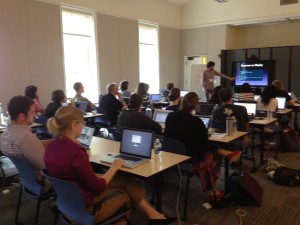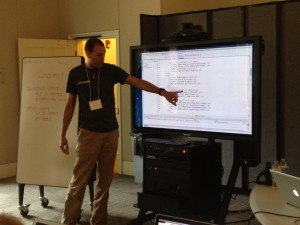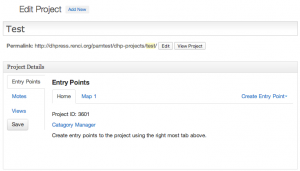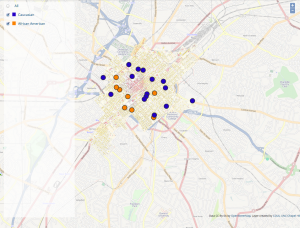I am pleased to announce that our leading DH Press pilot project, Mapping the Long Women’s Movement, is now online! This project represents a major collaboration between the Digital Innovation Lab, the Southern Oral History Program, and the Renaissance Computing Institute. Read more.
This project, which has been the primary use case for developing the beta release of DH Press, has been a long time in the making. What began as a tentative conversation with SOHP Digital Humanities Coordinator, Seth Kotch, in February 2012 is now a full-fledged project. We had an idea that we wanted to spatialize/map a collection of oral histories that all spoke to the importance of place and space in the women’s movement in Appalachia. But this project is so much more than a visualization of sound. Read more about the project.
Project Highlights
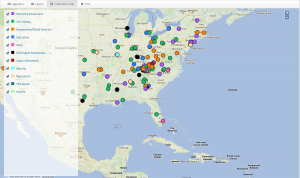
Visualizing oral history: each marker on the map represents a segment of an oral history.
Mapping the Long Women’s Movement offers an innovative approach to delivering digitized oral history content. Traditional library catalogs may host an oral history’s full audio file, accompanied by a transcript (often as a PDF). But this system is often inadequate for finding what you’re looking for, since it relies upon limited indexing and in-browser searching (which only works for exact text matches). And while the audio files are accessible, they are typically underutilized because it is far easier to skim a transcript than listen to a long interview.
Our project allows users to explore audio files and accompanying transcripts by jumping directly into the audio file, using the transcript and the map-based visualization as anchors for searching and browsing the content. Each marker on the map is associated with a segment of an audio file. When you click on a marker, you’ll be able to listen to that section of the interview, read the corresponding transcript, and see additional information about that audio segment. You can then link out to the full audio/transcript, where you can listen to the entire file or jump around as you like.
Start Exploring
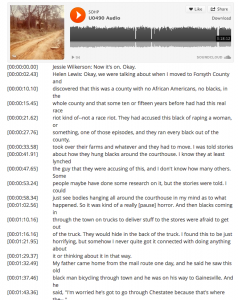
Explore the audio/transcript with a click of the mouse.
When you launch the project, you’ll be taken to a map with lots of markers on it. These represent stories categorized by eleven unique concepts — the women’s movement, life history, movements/social activism, etc. — across the forty-eight interviews in the project. You can switch the markers you see on the map by changing the layer (each layer filters the markers based on a different attribute in the data). You can filter the map by concept, type of space, interviewee, or interviewer.
Each marker you click will bring up a different excerpt of an interview; you can listen to that section or jump out to the entire interview. When listening to the entire interview, you’ll be able to jump to any point in the audio or transcript with a simple click of your mouse: either drag the red line in the media player, or click on any point in the transcript to start jumping around. It’s that easy!
You can also link out to related content from each marker. By clicking the “concept link” in each marker bubble, you can see a set of related markers based on that concept. So if you are exploring the theme of feminism, you can see a set of related content across all of the interviews.
We’ll start formal user testing with this project in the Fall 2013 semester. In the meantime, email me to let us know what you think about the project!
Look for additional features, including a timeline visualization and “topic card” visualization, to come online soon!
Special thanks to the DH Press development team: Joe Hope (RENCI), Stephanie Barnwell & Jade Davis; along with our former contributors: Joe Ryan, Chien-Yi Hou, and Bryan Gaston, and all of our wonderful undergraduates: Chris Breedlove, Beth Carter, Charlotte Fryar & Lauren Stutts. At the SOHP: Jessie Wilkerson, Liz Lundeen and Hudson Vaughan did a great job creating and verifying the content. And, of course, a major thank you to Seth Kotch, our client/PI, for his everlasting patience and good humor as we stumbled along.


